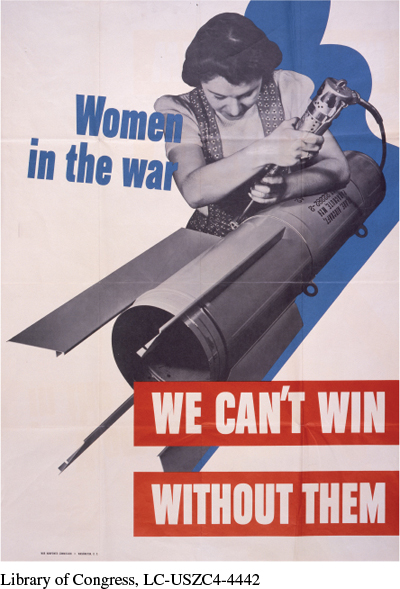New Opportunities for Women
World War II opened up new opportunities for women in the paid workforce. Between 1940 and the peak of wartime employment in 1944, the number of employed women rose by more than 50 percent, to 6 million. Given severe labor shortages caused by increased production and the exodus of male workers into the armed forces, for the first time in U.S. history married working women outnumbered single working women. At the start of the war, about half of women employees held poorly paid clerical, sales, and service jobs. Women in manufacturing labored mainly in low-wage textile and clothing factories. During the war, however, the overall number of women in manufacturing grew by 141 percent; in industries producing directly for war purposes, the figure jumped by 463 percent. By contrast, the number of women in domestic service dropped by 20 percent. As women moved into defense-related jobs, their incomes also improved.
As impressive as these figures are, they do not tell the whole story. First, although married women entered the job market in record numbers, most of these workers were older and without young children. Women over the age of thirty-five accounted for 60 percent of those entering the workforce. The government did little to encourage young mothers to work, and few efforts were made to provide assistance for child care for those who did. In contrast to this situation, in Great Britain child care programs were widely available. Second, openings for women in manufacturing jobs did not guarantee equality. Women received lower wages for labor comparable to the work that men performed, and women did not have the same chances for advancement. Typical union benefits, such as seniority, hurt women, who were generally the most recent hires. In fact, some contracts stipulated that women’s tenure in jobs previously held by men would last only for the duration of the war.

Gender stereotypes continued to dominate the workforce and society in general. Magazine covers with the image of “Rosie the Riveter,” a woman with her sleeves rolled up and her biceps bulging, became a symbol for the recruitment of women, but reality proved different. Women who took war jobs were viewed not so much as war workers but as women temporarily occupying “men’s jobs” during the emergency. As the war drew to a close, public relations campaigns shifted gears and encouraged the same women they had recently recruited to prepare to return home.
Exploring American HistoriesPrinted Page 765
Exploring American Histories Value EditionPrinted Page 562
Chapter Timeline